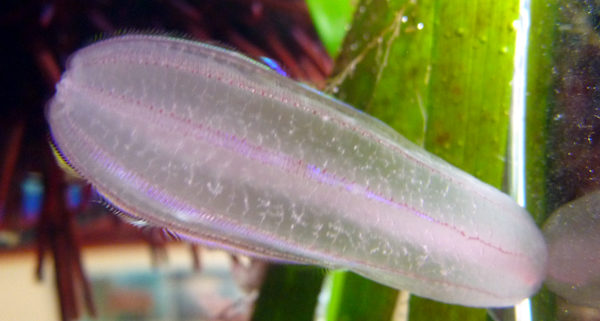Beroid Comb Jelly (Beroe abyssicola)
Common name: Beroid Comb Jelly
Scientific name: Beroe abyssicola
Size range: up to 7 centimetres
Identifying features
Beroe abyssicola has a cylindrical shape with rounded ends, they bear eight evenly spaced rows of cilia or “combs” which they beat in waves for locomotion. the comb rows stop just before the oral end where a mouth, resembling a pair of lips, is located. Their most distinguishing characteristics are their translucent, pinkish red colouration through which their more intensely coloured pharynx is visible, as well as their complete lack of tentacles.
Habitat
They inhabit the waters of the North Pacific at an average depth of 1028-1840 metres. They will occasionally come to the surface, however they may lose their pinkish colouring in the process.
Prey
Beroe abyssicola is a carnivorous predator that swims, hunting for prey, with its mouth closed for a more streamlined shape. when it encounters prey, of which it prefers other ctenophores, it can open its mouth to quickly engulf its prey. It can even swallow other ctenophores larger than itself, or bite pieces off with its fused cilia, called macrocilia that line the inside of its mouth and function as simple teeth.
Predators
Not much is known about what exactly preys upon Beroe abyssicola, but the most likely predators are other ctenophores, jellyfish and other animals like fish and sea turtles.
Life cycle
Beroe abyssicola is a hermaphroditic species, meaning that it has both female and male gonads. As a result it is thought to be able to occasionally fertilize its own eggs. Regardless it will eject its sperm and/or eggs directly from the mouth into the open water where the eggs are fertilized externally. After fertilization the eggs will go through a larval stage, resembling a smaller adult, that will grow into a full adult. Throughout the life cycle it will remain part of the phytoplankton and is therefore considered holoplanktonic.
Behavior
Beroe abyssicola does not have a very complex nervous system; it has a loose net of nerves spanning its body called a nerve net that may be more concentrated near sensory organs. Because of its simple nerve network it is limited to simple behaviors, such as swimming and navigating for prey, maneuvering away from obstacles and feeding on located prey, which it is able to sense with chemo receptors.
Photographs and Video by Adam Kitzler and D. Young


